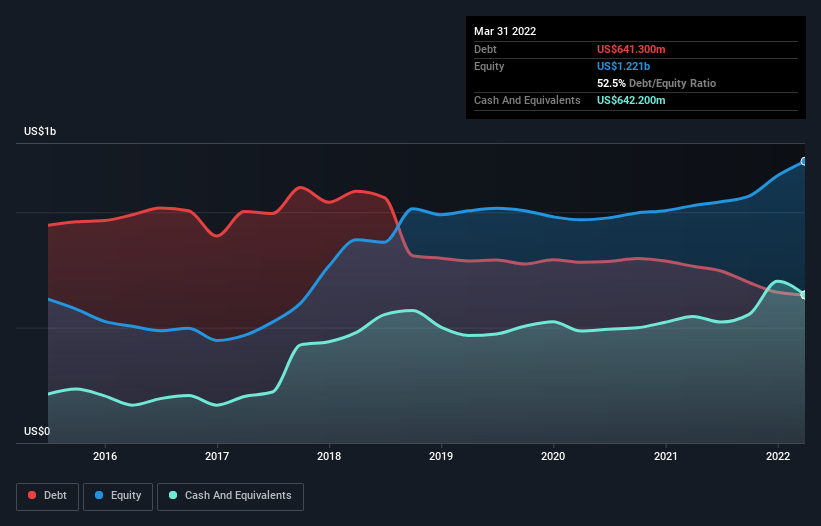We Think Valhi (NYSE:VHI) Can Manage Its Debt With Ease
Warren Buffett famously said, 'Volatility is far from synonymous with risk.' So it might be obvious that you need to consider debt, when you think about how risky any given stock is, because too much debt can sink a company. Importantly, Valhi, Inc. (NYSE:VHI) does carry debt. But the more important question is: how much risk is that debt creating?
When Is Debt Dangerous?
Debt assists a business until the business has trouble paying it off, either with new capital or with free cash flow. Part and parcel of capitalism is the process of 'creative destruction' where failed businesses are mercilessly liquidated by their bankers. However, a more common (but still painful) scenario is that it has to raise new equity capital at a low price, thus permanently diluting shareholders. Having said that, the most common situation is where a company manages its debt reasonably well - and to its own advantage. The first step when considering a company's debt levels is to consider its cash and debt together.
See our latest analysis for Valhi
What Is Valhi's Debt?
The image below, which you can click on for greater detail, shows that Valhi had debt of US$641.3m at the end of March 2022, a reduction from US$765.5m over a year. But it also has US$642.2m in cash to offset that, meaning it has US$900.0k net cash.
A Look At Valhi's Liabilities
According to the last reported balance sheet, Valhi had liabilities of US$451.0m due within 12 months, and liabilities of US$1.35b due beyond 12 months. On the other hand, it had cash of US$642.2m and US$443.3m worth of receivables due within a year. So it has liabilities totalling US$716.8m more than its cash and near-term receivables, combined.
This is a mountain of leverage relative to its market capitalization of US$1.17b. This suggests shareholders would be heavily diluted if the company needed to shore up its balance sheet in a hurry. While it does have liabilities worth noting, Valhi also has more cash than debt, so we're pretty confident it can manage its debt safely.
Even more impressive was the fact that Valhi grew its EBIT by 146% over twelve months. If maintained that growth will make the debt even more manageable in the years ahead. The balance sheet is clearly the area to focus on when you are analysing debt. But you can't view debt in total isolation; since Valhi will need earnings to service that debt. So when considering debt, it's definitely worth looking at the earnings trend. Click here for an interactive snapshot.
Finally, a business needs free cash flow to pay off debt; accounting profits just don't cut it. While Valhi has net cash on its balance sheet, it's still worth taking a look at its ability to convert earnings before interest and tax (EBIT) to free cash flow, to help us understand how quickly it is building (or eroding) that cash balance. Over the last three years, Valhi recorded free cash flow worth a fulsome 100% of its EBIT, which is stronger than we'd usually expect. That positions it well to pay down debt if desirable to do so.
Summing up
While Valhi does have more liabilities than liquid assets, it also has net cash of US$900.0k. And it impressed us with free cash flow of US$312m, being 100% of its EBIT. So we don't think Valhi's use of debt is risky. There's no doubt that we learn most about debt from the balance sheet. However, not all investment risk resides within the balance sheet - far from it. For instance, we've identified 2 warning signs for Valhi (1 is significant) you should be aware of.
If, after all that, you're more interested in a fast growing company with a rock-solid balance sheet, then check out our list of net cash growth stocks without delay.
Have feedback on this article? Concerned about the content? Get in touch with us directly. Alternatively, email editorial-team (at) simplywallst.com.
This article by Simply Wall St is general in nature. We provide commentary based on historical data and analyst forecasts only using an unbiased methodology and our articles are not intended to be financial advice. It does not constitute a recommendation to buy or sell any stock, and does not take account of your objectives, or your financial situation. We aim to bring you long-term focused analysis driven by fundamental data. Note that our analysis may not factor in the latest price-sensitive company announcements or qualitative material. Simply Wall St has no position in any stocks mentioned.

 Yahoo Movies
Yahoo Movies 

